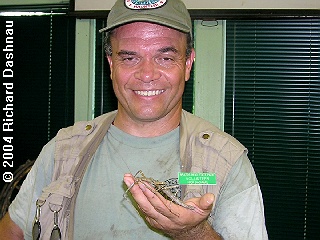
Welcome to the Visitor's Center at Brazos Bend State Park. That's me with the giant walking stick (06/20/2004). This page features ant lions.
Go back to my home page, Welcome
to rickubis.com
Go
back to the RICKUBISCAM page.
----------------------------------
Welcome
to the Visitor's Center at Brazos Bend State Park. That's me with the giant
walking stick (06/20/2004). This page features ant lions.
August 08, 2011 I
finally got another chance to try with the antlion pits outside at the
park. Using the same setup from July 24, this time I was able to catch
some antlion
action, this time with an ant in the pit. The two images
below are frame-captures from video clips that I shot. The edited
footage is here. (wmv, 20.2mb).
-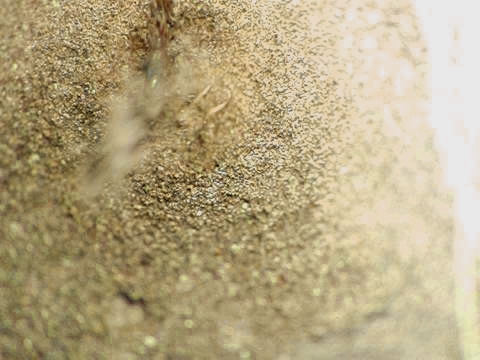 --
-- -
-
TOSSING
SAND
THE JAWS ABOUT TO CLOSE
July 24, 2011 I
had been looking at the antlion pits scattered about the Visitors' Center at BBSP, and started
thinking about when I'd filmed antlions before. When I checked,
I saw that
it was about 5 years ago!! I updated and edited some of the material from then, and made this new Antlion Page.
On this afternoon, I had a sudden idea, and
started assembling
some of my various camera hardware as shown below. This is from a
collection of odds and ends I've gathered over time.
-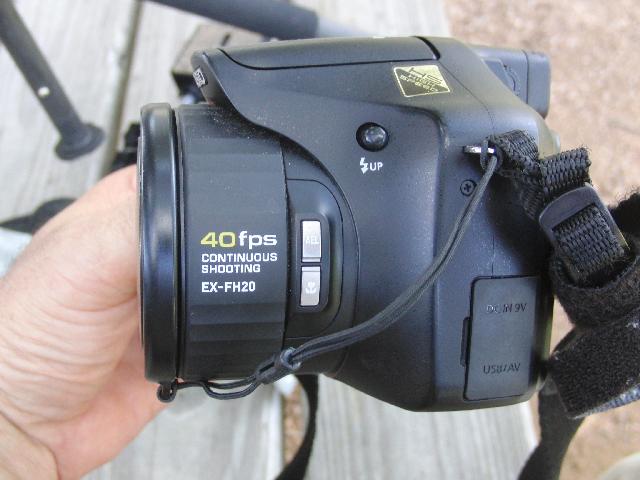 --
--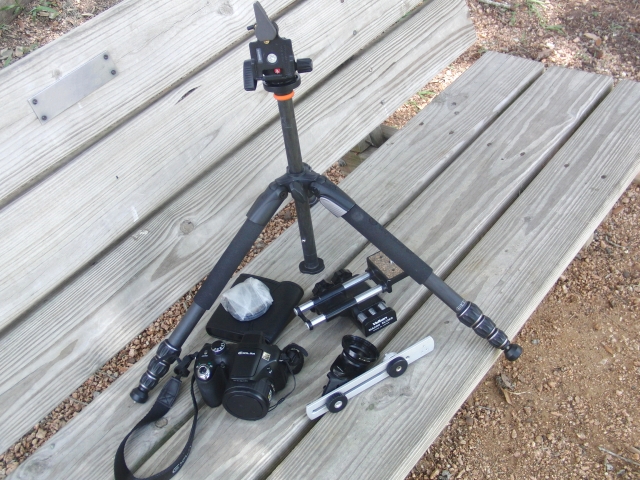 --
--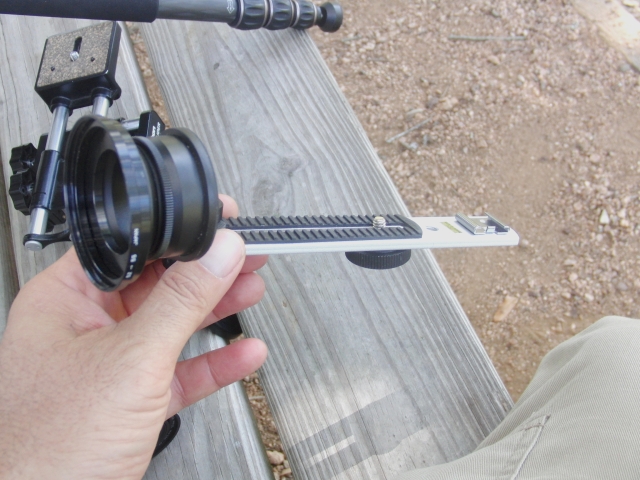 --
--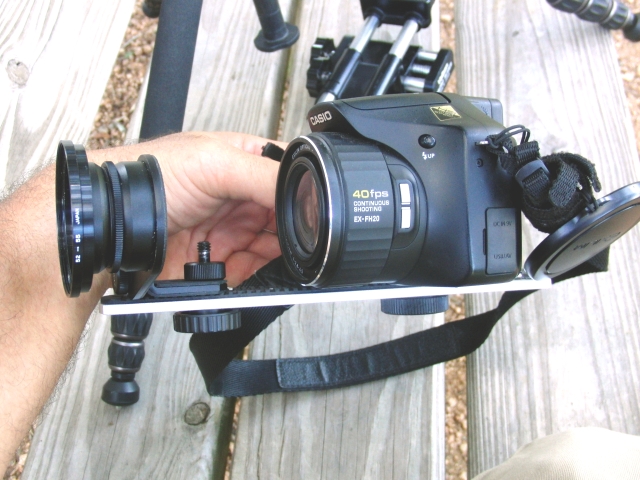
CASIO
EX-FH20
THE PARTS
LENS ADAPTOR AND RAIL
ATTACH THE RAIL
 --
--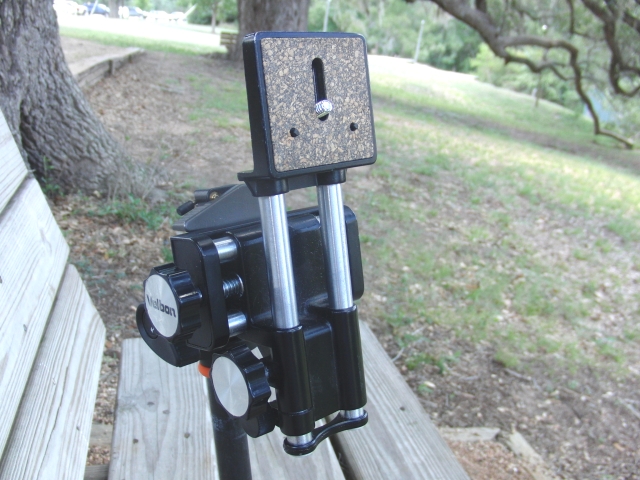 --
--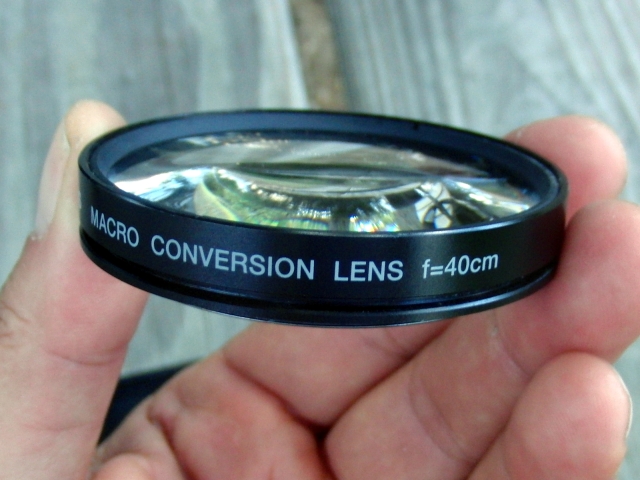 -
--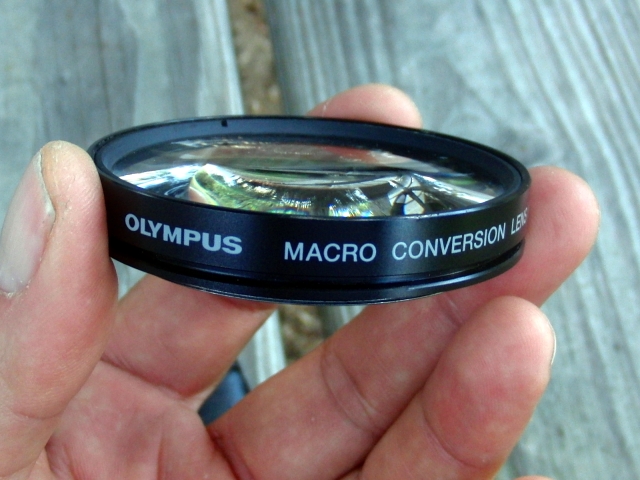 -
- -
-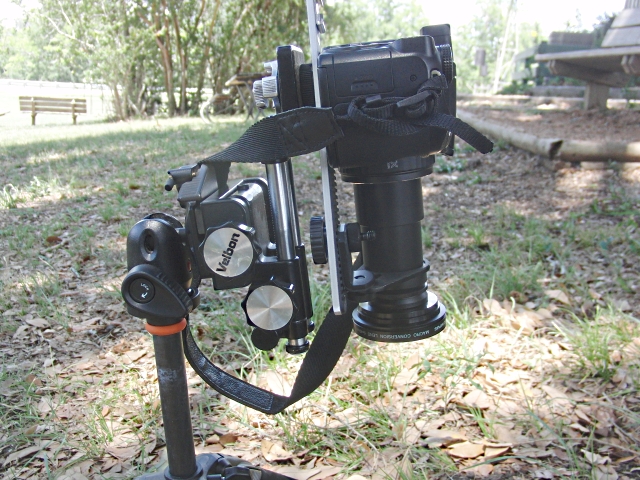 -
-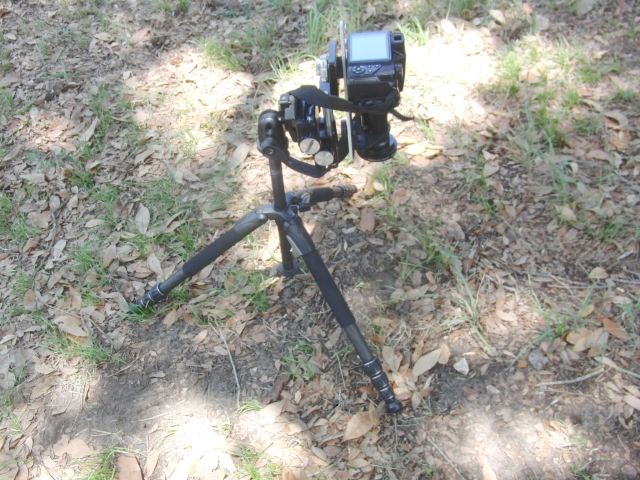
MACRO
CONEVERSION LENS AGAIN
INSTALL THE LENS
ASSEMBLY ON THE TRIPOD
TEST FOCUS ON GROUND
-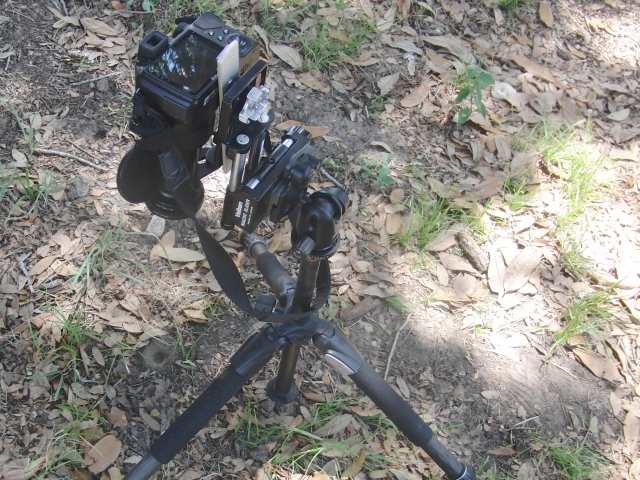 -
-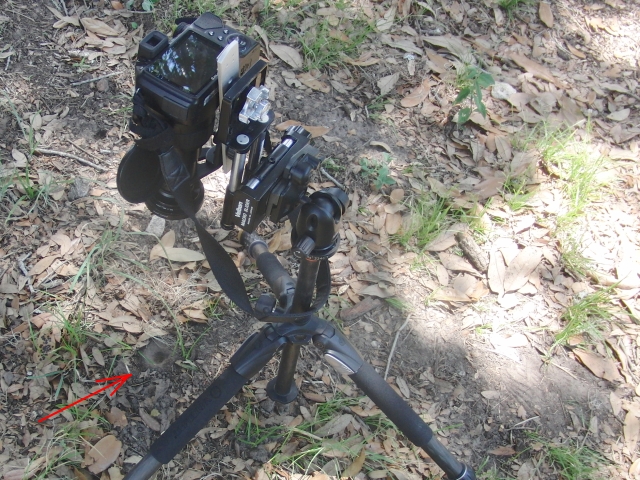
SET UP
OVER ANTLION PIT
ARROW POINTS AT THE PIT
IN FOCUS
I
was trying to set up so that I could shoot some high-speed video of the
antlion at work. When the antlion move, it moves very quickly, and I
was hoping to slow that movement
down a bit. Today's RICKUBISCAM
is a frame grab from some of the video clips I shot. I've edited
some of them together into this video clip. (13.2mb) In this clip, the Ant Lion
is just setting its trap. Other clips will follow soon.
April 08, 2006--
The second
adult Ant Lion emerged today! This time, I had a bit more time to
get pictures before I released it. Here it is, one picture showing it
on my finger, and the next
one outside, where I left it. (Images
added to this page 5/26/2014)
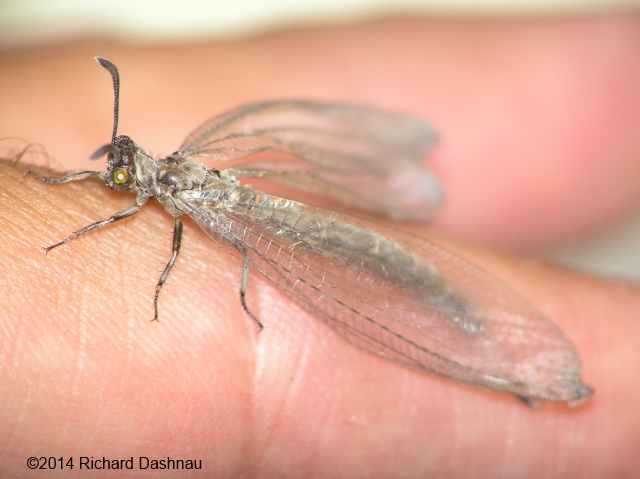 --
--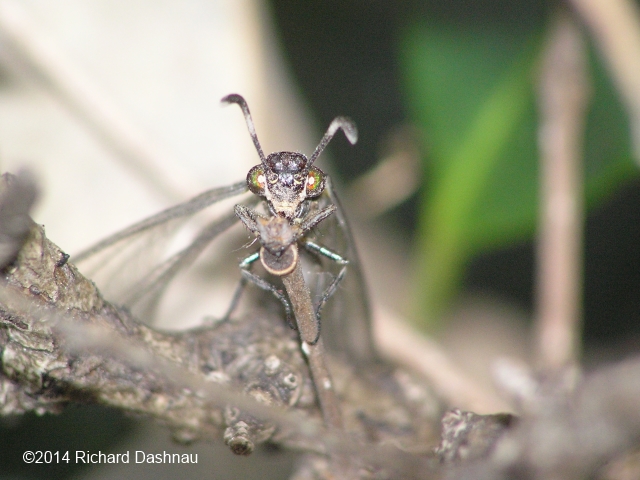 --
--After I released the ant lion, I sifted the sand again. Now I had two opened cocoons to examine. I took better close-up shots, and these showed how intricate they were.
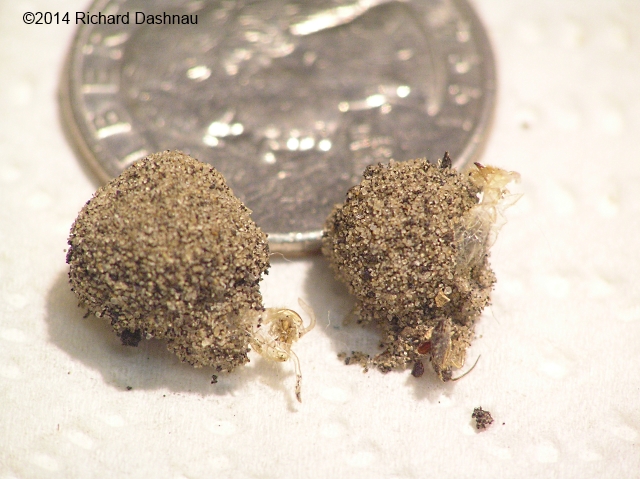 --
--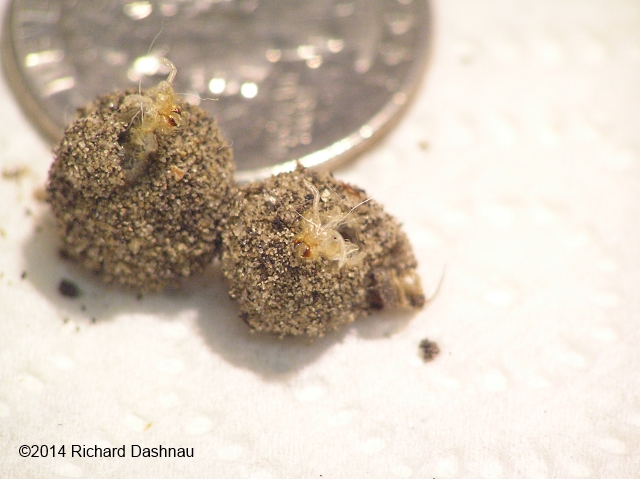 --
--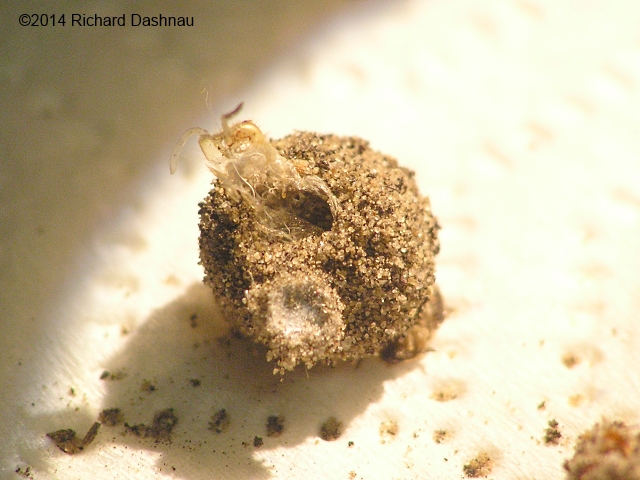 --
--
There
is apparently a silk lining, which is covered with sand grains. Even
without the larva inside, the cocoon kept its shape (although I didn't
try to crush them). Apparently the new Ant Lion
pushes partially
out of the cocoon, then splits (similar to a dragonfly larva) along the
back,. This allows the full adult to emerge. I didn't see how it dug
its way to the surface, but it must have
enough time to get there
before the wings start to expand and harden. I really liked the "hatch"
that seemed to form in one of the cocoons.
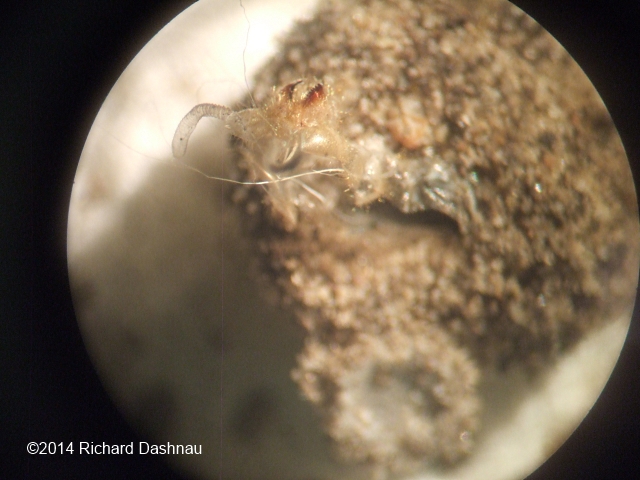 --
-- --
--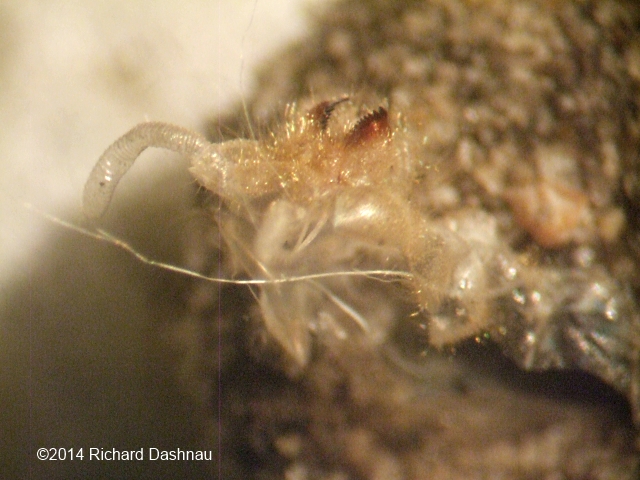 -
-
I've
had varied success taking pictures through the binocular microscope. I
tried again, getting some reasonable close shots of the cocoons.
The first two images above show
how shallow the depth-of-field is.
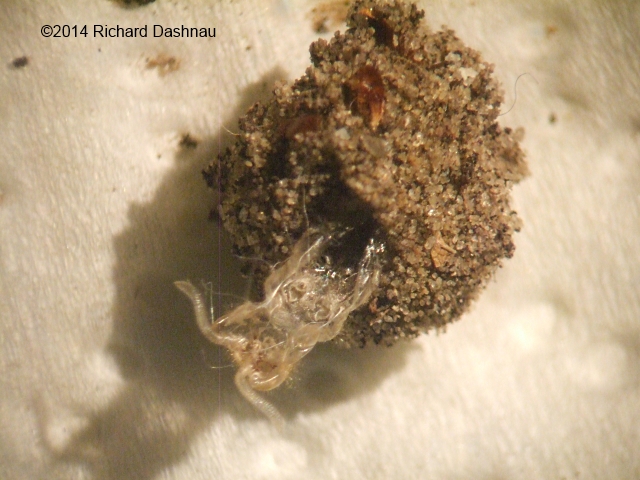 --
--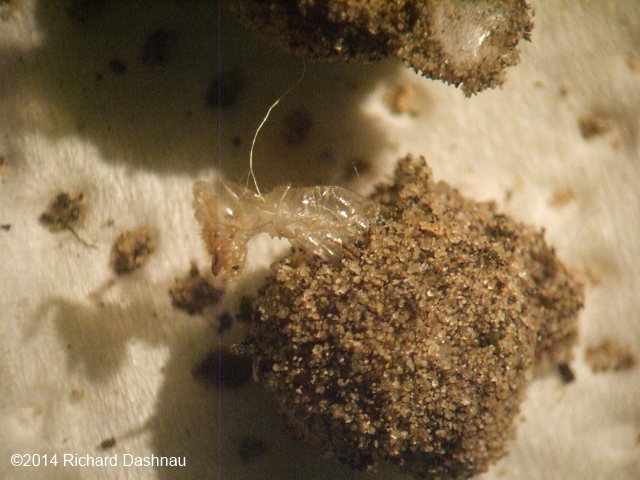 --
-- -
-
April 06, 2006-- An
adult Ant Lion emerged yesterday (04/05/2006)! But, I had to release it
before I got any good pictures. I sifted the sand again, and I found
two round, sandy
objects. These were the cocoons that the ant lions
used. One has opened (which relased the aduly I'd seen) and the other
one had not yet. I put the unopened one back under the
sand. Below are
a few images of the two cocoons. (Images added to this page 5/26/2014)
 --
--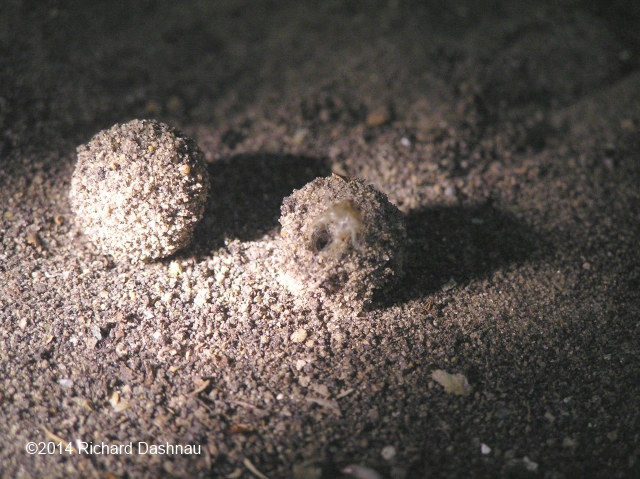 --
--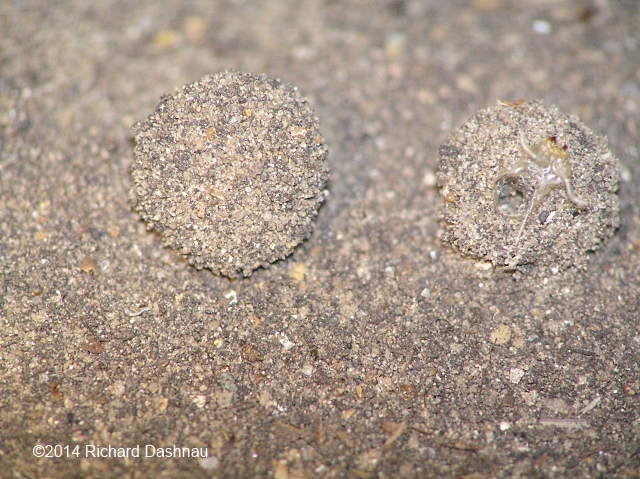
January 11, 2006-- After
a period of inactivity by the ant lion larvae; I decided to look for
them. I carefully put the sand through an ordinary cooking strainer
until I found the ant lions.
They both looked fine. Here they are, next
to a quarter. (Images added to this page 5/26/2014)
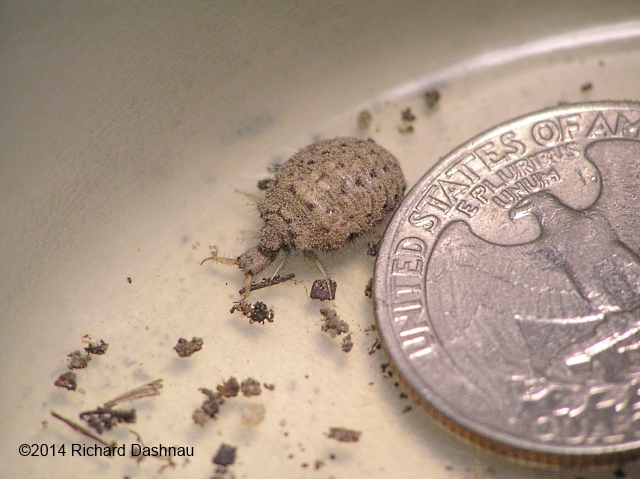 --
--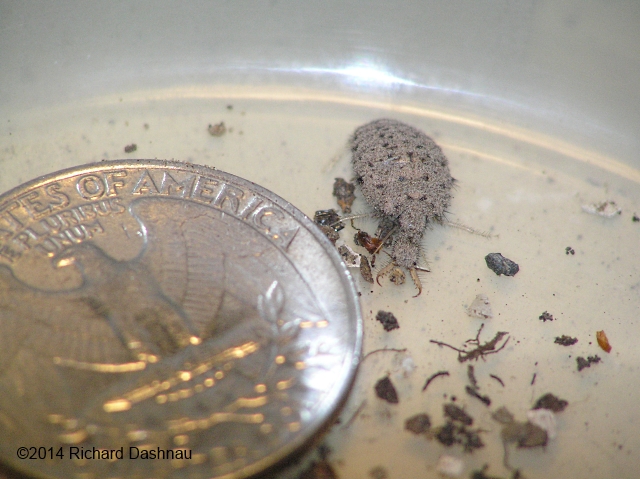 --
--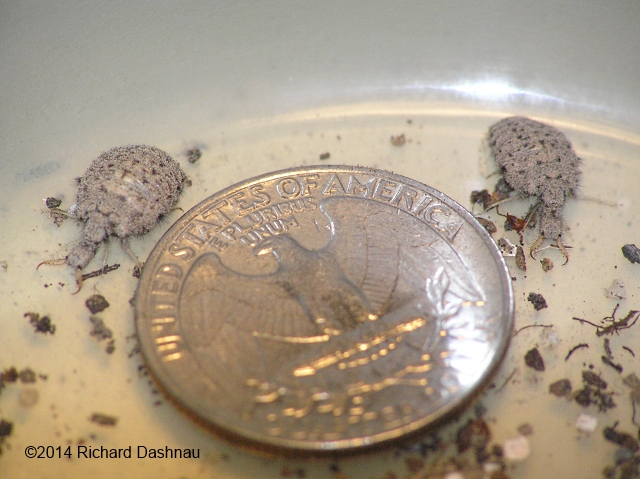
ONE ANT LION
THE
OTHER ANT LION
BOTH ANT L IONS
December 03, 2005-- The images below are frame captures from this video clip (wmv 33mb), shot through the microscope.
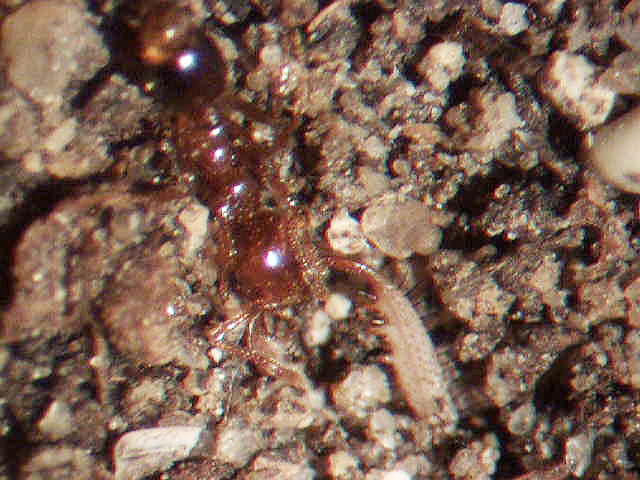 --
--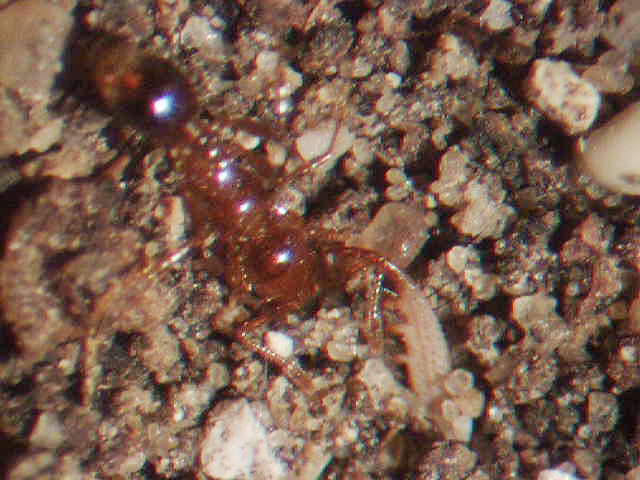 --
--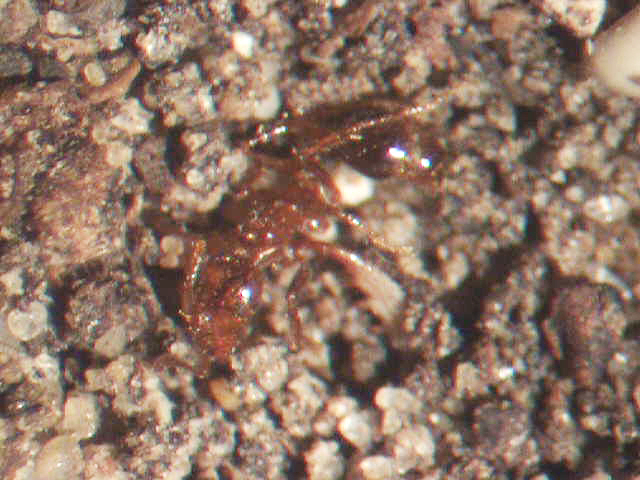 -
-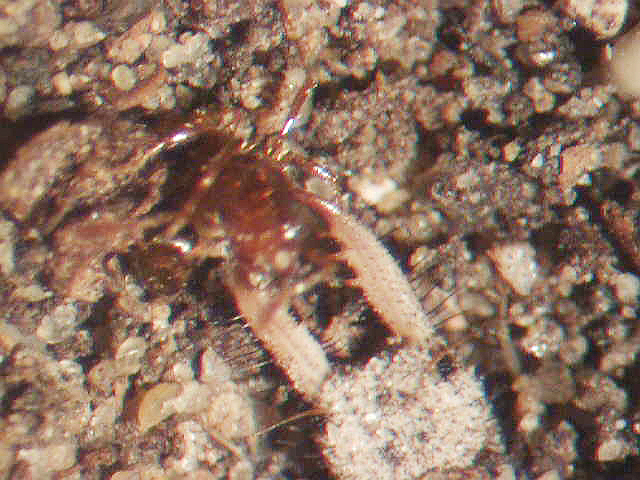 -
-
AIR BUBBLES IN HEAD
BIGGER BUBBLE IN HEAD EVEN BIGGER BUBBLE THE MONSTER'S HEAD
Viewed
at such magnification, the dexterity of the mandibles is more than I'd
expect. They are extremely mobile. In this video clip
(wmv 33mb), one can see the formation of voids (or air bubbles)
inside the ant as the insides are drained. Seen at this magnification,
the mandibles still look sharp and intimidating.
November
19, 2005-- The Antlions are still in
my kitchen. From time to time I've been able to watch them eat. Since the
previous "article", I've been working towards getting better photos through
my microscope. I'd really like to show the variance in fluid pressures
and how this can be seen. I've been able to see fluid movement ( a sort
of "milky" substance) that flows into an ant segment
when the antlion
has pierced it. I've also witnessed many more times the formation of large
voids or bubbles inside an ant as its fluids are drained. I've seen, once,
apparent fluid movement in the
mandible of an antlion...moving towards
the head of the antlion. This was shown by small bubbles or particles
I could observe moving. A softer-bodied insect without the radical separation
of body
segments--like a cockroach nymph--will actually swell up slightly
after being pierced by the antlion. Cessation of movement in these insects
happens much faster than in ants. The nymph will swell,
and on a few occasions it seemed that fluid might have even begun oozing from joints in the nymph.
It appeared that a slight sheen or glossiness appeared at various points,
but I can't be sure if
that was fluid leaking. If there is enough pressure
to cause this effect when the antlion injects its digestive juices, then
why doesn't fluid leak from around where the mandibles have pierced the
prey?
After
a short interval, the cockroach nymph begins deflating as the antlion feeds.
Another
fact I've learned as that even though the antlion attack is generally engineered
so that confrontation is in the antlion's favor, those long mandibles are
not always the best for the attack of for
manipulating prey. The tips
of the mandibles have to pierce the prey insect. I've witnessed a number
of times where the mandibles have closed with the "teeth" clamped around
the pedicel (narrow
part between abdomen and thorax) and the piercing ends
uselessly crossed over the prey insect's back. After the prey is dead,
the antlion manipulates the body with those oversized tongs, and
has to
arrange it so that one or both of the ends of the mandibles can
pierce the insect. This can be a laborious process, requiring much manipulation
with the mandibles and sharp jerks of the
head.
Then
the mandible points have to somehow pierce the hard shell. This is often
done through a joint or natural opening in the exoskeleton. In fact, watching
this, I thought there might be an
answer that Dr. Thomas Eisner brought
up in his book For the Love of Insects. He considered it quite amazing
that the antlion drained an ant's crop without piercing the acid sacs by
accident.
Perhaps the location of the joints in the exoskeletion covering
the ant's abdomen forces the points of the antlion's mandibles to miss
the rear of the abdomen just by physically turning them away.
The joins
seem to run across the axis of the ant's body, so they would might prevent
a mandible (which is sort of flattened top and bottom) from turning. This
would would keep the curve of the
antlion's mandible along the inside of
the abdomen, and running around the center axis instead of turning
parallel to it (and being able to point directly backwards).
From
time to time I've noticed
that one antlion or another allows its pit to
collapse and doesn't rebuild it--sometimes for days. Once, all four antlions
showed no activity for almost a week, so I scooped into the dirt and sifted
it
to see if they'd pupated. They hadn't, and twitched their way back underground
when I put them back. While I was sifting the dirt, though, I found the
two shed exoskeletons in these pictures.
These were buried under the dirt
(or fine sand--or whatever you want to call what I have them in), so I
assume that few people encounter these. All the features of the antlion
larva are shown in the
shed exoskeletons, including those fearsome jaws.
Below are a couple more pictures of these shells.
-------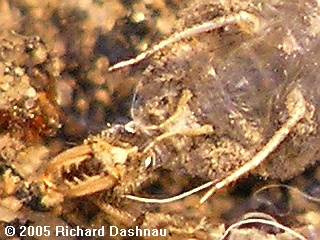 -----
-----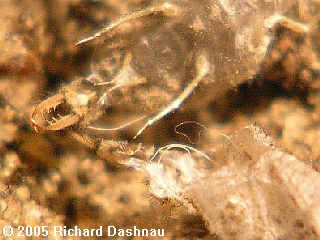 -------
-------
MOLD YOUR OWN ANTLION
KIT
THE FRONT SHELL, CLEARER
By the
way, one after another of the pits has been reformed since then, although
my mysterious fourth pit (the smallest one) disappeared for a couple of
weeks. I thought that one of the antlions
that were digging the large pits
might have eaten it. I've read that one must be careful to keep the antlions
spaced far enough apart to avoid this. The antlions keep moving their pits
around,
though, so sooner or later there could be a dispute. A few days
ago, however, my small pit reappeared.
I'll
be posting some better pictures of the antlions here soon.
----------------------------------------------------------------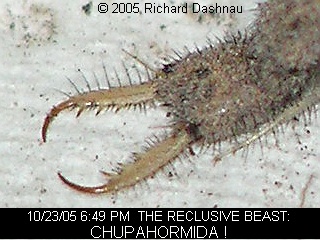 -
-
PRETTY
FEARSOME
This
creature, actually an insect, is actually the larval form of the insect
known as the antlion. This is a bit confusing, because it is actually the
larva that consumes ants. It is also known to some
people as the "doodlebug".
The
antlion digs a pit in loose soil by moving in circles and tossing the soil
out with swift movements of its head. Eventually a nearly-perfect funnel-shaped
pit forms
with the antlion lying at the very bottom, buried with only the
open jaws exposed.
When
a small insect approaches the pit, the loosely-sculpted walls allow the
edge to give way. This causes the
insect to slide to the bottom. If it
manages to stop this slide, then the antlion will start tossing sand at
it--with great accuracy--to cause it to continue its fall to the bottom.
There, the waiting jaws
snap shut on the prey. These jaws look like ice
tongs with extra teeth. The outermost points serve as piercing needles.
When they enter the insect, digestive enzymes work on the tissues inside,
liquifying them and causing the insect's slow death. Then the insect's
(or whatever else gets caught) liquified tissues are sucked out by the
antlion. This is all old news to some people. But...most
people don't
get to see an antlion in action.
Well,
we're going to see one here!
I had
just read a book called For Love of Insects by Thomas Eisner (Go
get it! If you like my pages at all, you'll LOVE that book!), and there
was a piece on antlions in it. I'd observed them when I
was a child, but
my interest was rekindled, and I collected some. I did this by carefully
scooping up some dirt which had antlion pits in it. When I got home, I
gently sifted the dirt, and found three
antlion larva. I prepared a dish
with dirt about 2 inches deep and, before putting the antlions in, I took
some pictures.
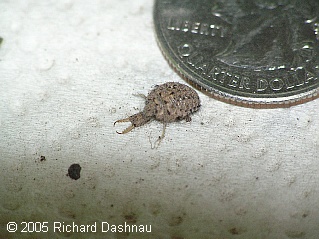 -
-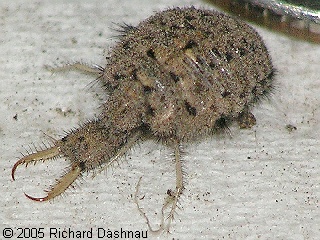 -
-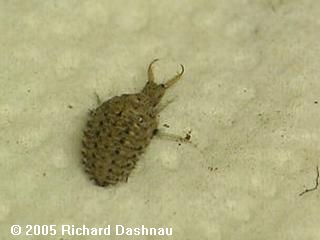 --
--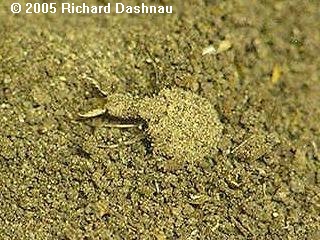
ANTLION WITH QUARTER
DANGEROUS
BUT...GOOFY?
REALLY PRETTY GOOFY
THIS COULD BE TROUBLE
VIDEO CLIP 559kb
VIDEO CLIP 1500kb
The
first picture shows my largest antlion near a quarter (WITH QUARTER, above).
Seen up close, and out of its element, the antlion larva looks like a child's
bad drawing of a nightmare creature.
(see DANGEROUS BUT...GOOFY? above)
Although equipped with a really formidable-looking pair of mandibles, the
rest of the creature is a ridiculous-looking lump with tiny eyes, tufts
of hair
sticking out, and some ludicrous stick legs seemingly tacked on.
The next image above (REALLY PRETTY GOOFY) is a frame from a short VIDEO
CLIP 559kb showing
the antlion as it starts
moving across a paper towel. This movement didn't
really help change the ludicrous image as it jerked in circles with occasional
flips of its head--probably a reflex with the intent to throw dirt.
I introduced
the antlions to their new home, where I took another VIDEO
CLIP 1500kb. Suddenly,
the antlion bore an uncomfortable resemblance to a fictional creature in
a movie. The movie was
"Tremors" (one of my favorites, by the way), and
I felt a slight sense of foreboding as the antlion suddenly moved with
purpose into the soil. It wasn't quite as "goofy" anymore. I've edited
the clip
slightly
to remove the slight pauses it made as it slipped under the dirt but I
haven't sped up its movement. After some time, I checked,
and found 3 funnels in my bowl (see ANTLIONS AT HOME,
below).
 -
-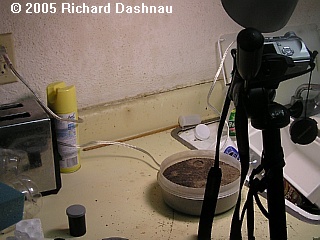 -
-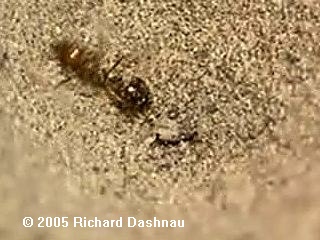 -
- -
-
ANTLIONS
AT HOME
PHOTO SETUP
THE ATTACK!
CASUALLY FEEDING
VIDEO CLIP 2500kb
VIDEO CLIP 537kb
I rigged
up a couple of lights, my tripod, and the camera so I could film what happened
next (see PHOTO SETUP, above).
This is the photo setup that I came up with on 11/10/2005:
What
happened next is...a Fire Ant fell into one of the sand traps. There was
a flurry of activity, and a pause, and more activity. The image above (THE
ATTACK) is a single frame from
this VIDEO
CLIP 2500kb . Note
that the ant seems to have been seized by the thorax. Also note the rapid,
violent beating the antlion gives to it. I guess the antlion doesn't seem
goofy at all by this
point.
After
some time, the ant stopped struggling. Then, the antlion began to...feed.
With casual deliberation, it moved from one body segment to the next, manipulating
the subdued ant with
movements of the huge jaws. It would move the ant
around, and the points of the jaws would find an opening, and they would
pierce the body. The next image above (CASUALLY FEEDING) is a
frame
from a very short VIDEO
CLIP 537kb showing
this manipulation. I like this clip because it gave me the illusion that
I was standing on the edge of the pit looking in...and then a few grains
slide
into the hole...and the clip ends. The
antlion continued this until it drained the ant. Finally, with a twitch
of its head, it tossed the empty remains out of the pit. Then, it moved
around, reformed the
pit, and set the trap again.
I've
got an old binocular stereo microscope that I set up over my bowl. I've
watched a few feedings since the first one.
Unfortunately, I can't take
pictures through the microscope. I watched, however, in close detail as
the antlion probed with its jaws. Also, a few days later, a new
pit formed. This was much smaller,
but it was also inhabited by an antlion--although this one had very dark jaws unlike the first 3. I have no idea where this
one came from, although it could have been in the dirt I picked up near
my
apartment. Anyway...I have 4 pits now.
Under
a very bright light, the exoskeleton of the ant is almost transparent.
I watched as--one time--one of the antlions pushed the tip of a mandible
into the joint where the ant's mandible was
attached to its head. Then, I noticed a lighter spot form (after some time). It was an AIR BUBBLE!
This was verified when the antlion shifted the ant's position. The bubble
inside the head moved
to the highest point. This bubble slowly got larger
the few times I went back and checked. Imagine that: the invasive piercing
of those sharp needles--then the injection of digestive enzymes into
the
living creature--and finally the slow, deliberate draining of the liquifying
bodily tissues. Seen that way, it's pretty horrifying; especially
when contrasted with the "goofy" appearance of the
creature doing it.
Dr.
Thomas Eisner's book, For the Love of Insects, talks about antlions
on pages 264-273. In it, Dr. Eisner mentioned some very interesting facts.
Apparently, most of the volume of the material
drained by the antlion is
the contents of the ant's crop (it's storage stomach). This must happen
while the antlion is probing the ant's body with its pair of sharp mandibles
(by the way, I noticed that
sometimes the points appear to get "stuck",
and requires quite a bit of movement on the antlion's part to get them
unstuck.). The antlion does this probing without breaking or poking into
any acid
reservoirs that the ant has inside it for use during spraying
offense. The
antlion doesn't have a protective covering. It doesn't need one. While
it's in the sand, it is protected by being unseen; and
also by the massed
grains around it. Dr. Eisner's book had an interesting observation about
this situation and ants. In his studies, he used the ant camponotus
floridanus, the Florida Carpenter
Ant. This is known as a "formicine"
ant. It attacks by clamping with its jaws and spraying formic acid into
any wounds thus formed. On the other hand, I am using Fire Ants. It's hard
to tell, but they
are probably RIFA (red imported fire ants) or Solenopsis
invicta (wagneri).
I learned today that Texas already had native species
of Fire Ants, that are nowhere near as destructive as the invading non-native
RIFA. The RIFA attack by biting first, and--while holding on with
the mandibles--jamming
a stinger into their enemy. In both cases the chemical attack isn't
made unless the ant grabs something with its jaws! That means that
if something attacks the ant, and the
ant cannot grab it, then the ant
will not bring chemical defences to bear on its attacker. An antlion ambushing
from under the sand and shaking the ant around prevents the ant from biting
and is
probably safe from counter attack. I suspect the violent shaking
(which doesn't always happen, but often does) disorients the ant and may
either help the antlion's mandible points work in into the
ant and/or may
hasten action of the injected chemicals. That "goofy-looking" insect
is quite deadly in its element.
Also,
the antlion doesn't have an anus. That means that it does not defecate,
and
that wastes are stored inside the body. These are not released until
after the mature antlion emerges from its pupa--that is AFTER it has lived
for some time as a larva and metamorphosed.
(Eisner, page 270).
Do you
think prepubescent human children are hard to get along with sometimes?
What would happen if--along with waiting until maturity before they could
drive, or vote, or drink, or move out of the
house--they had to wait until
then to take their first...well, you get the idea. Now,
to get back to that other "name" for the antlion that I came up with. "Chupacabra",
when translated from Spanish,
means "goat sucker". "Chupa" is a form of
one of the verbs for "suck". "Cabra" means goat. Therefore, since "hormida"
means "ant", I figured I could call this elusive beast that hides in shadow
(well, dirt), strikes without warning, and SUCKS THE FLUIDS OUT OF ITS
HELPLESS PREY...the CHUPAHORMIDA, or "ant sucker".
Brazos Bend State Park The main page.
Brazos
Bend State Park Volunteer's Page The
volunteer's main page.
Go back to my home page, Welcome
to rickubis.com
Go
back to the RICKUBISCAM page.
Go
back to the See the World
page.